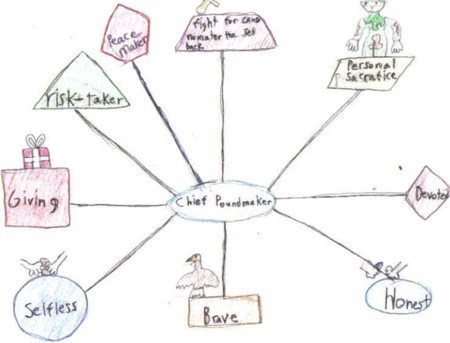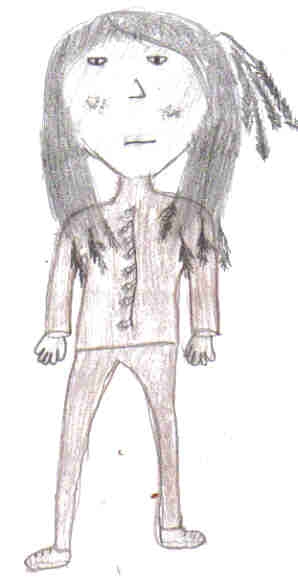 |
| Chief Poundmaker Web (I made it.) |
Chief Poundmaker was a Cree Chief born in 1842 near Battleford, Saskatchewan. His mother was a mixed blood Cree and his father was an Assiniboia shaman named Sikakwayan. Poundmaker had a brother and a sister. His brother’s name was Yellow Mud Blanket. Poundmaker’s family was living in the Great Slave Lake area when his father died. His mother took the children to live with her parents. She died soon after and the kids were raised by their grandparents and the Red Pheasant Band. In 1873, Chief Crowfoot adopted Poundmaker. Poundmaker got his name because he had a special ability to attract buffalo into pounds. A pound was like a huge corral where buffalo were stampeded or herded.
 |
| Chief Poundmaker (I made it.) |
Chief Poundmaker was known as a peacemaker and defender of his people by both the native and non-native communities. He was an important person during the period of the expansion of the treaty system and settlers into Saskatchewan. Chief Poundmaker took responsibility for his tribe and also had done much to protect his people. He was also known for how he treated people. He stepped in to prevent members of his tribe from attacking retreating forces during a battle. Poundmaker also prevented the prisoners from coming to harm at the hands of their captors. One of the most important things Poundmaker is remembered for was he was able to get the Government to agree to a section in Treaty Six that guaranteed food and supplies for his tribe during times of famine. When the Government failed to fulfill this promise, Poundmaker became active in the native rebellion. Throughout the rebellion Poundmaker urged peace, but was prepared to sacrifice his life to preserve his tribe. Poundmaker showed great bravery when he led the battle at Cutknife Hill against 350 people. For his participation in the rebellion, Poundmaker was charged with treason and sent to jail for 3 years. He was let out 6 months early because he wasn’t in good health. Shortly after Poundmaker was released from jail, he was participating in the Blackfoot sun dance when he burst a blood vessel in his lung and bled to death in minutes. This happened on July 4, 1886.
 |
| Poundmaker giving treaty. (I made it.) |
Was Chief Poundmaker a hero? How the natives and non-natives viewed Poundmaker when he was alive was very different. The natives thought Poundmaker was a hero because he protected them. Also they thought he tried to get the best deal possible for them. The non-natives thought he was a traitor and the only thing he wanted was war. I think Poundmaker is a hero because he was willing to stand up for what he believed in and would sacrifice himself for his people's freedom. Today Poundmaker is remembered by both natives and non-natives for his leadership and trying to achieve peace. Poundmaker has had many things named after him in Saskatchewan including Chief Poundmaker School, The Poundmaker Trail, Chief Poundmaker Historical Centre, Poundmaker Memorial Scholarship and Poundmaker's Lodge.
I chose Chief Poundmaker as my hero because I wanted to learn about someone I didn’t know anything about and someone who was important to Canadian history.
Page created on 4/21/2007 12:00:00 AM
Last edited 4/21/2007 12:00:00 AM
